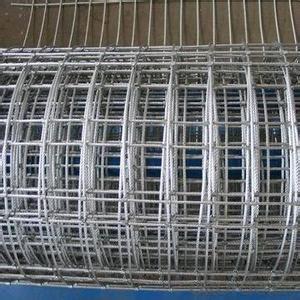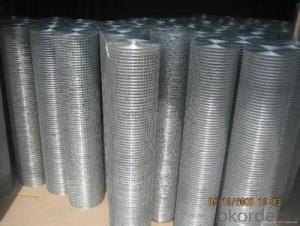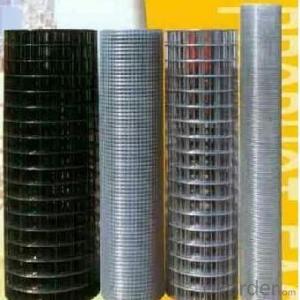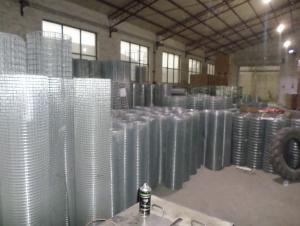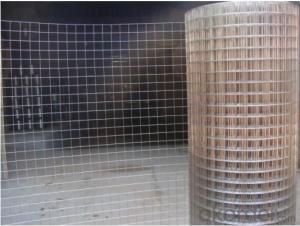Welded wire mesh-1 X 2
- Loading Port:
- China Main Port
- Payment Terms:
- TT or LC
- Min Order Qty:
- 50 roll
- Supply Capability:
- 5000 roll/month
OKorder Service Pledge
OKorder Financial Service
You Might Also Like
Introduction of Welded Wire Mesh
Welded Wire Mesh is made of by high quality galvanized wire, Low carton steel wire, stainless steel wire, iron wire, Galvanized steel wire, PVC coated iron wire in blue, green, yellow and other colors.
Application of Welded Wire Mesh
Galvanized welded wire mesh, PVC coated welded wire mesh for garden, feeding agriculture, fishing, poultry, mine field, lawn cultivation, and profession’s guard, decorate machine protection. Special welded wire mesh, (Heavy)welded wire mesh panel service as fencing mesh for transportation industry, construction a agriculture.
Surface treatment of of Welded Wire Mesh
a. Black (mild steel wire)
b. Electro galvanized, (galvanized before welding, galvanized after welding)
c. Hot dip galvanized, (galvanized before welding, galvanized after welding)
d. Pvc coated welded wire mesh, (black wire mesh then pvc coated, electro gal. then pvc coated, hot dip gal. the pvc coated)
Advantage of Welded Wire Mesh
Our welded wire mesh has strong corrosion-resisting and oxidation-resisting with good quality and rock bottom price.
Packing of Welded Wire Mesh
1. Waterproof paper then PVC shrinking Film
2. PVC shrinking film only
3. Black waterproof paper only
4. Waterproof paper then metal/wooden pallet
5. Plastic film then carton
(Also as your request. )
Pictures of Welded Wire Mesh



Specification of Welded Wire Mesh
Standard Welded Wire Mesh (in 30m length, Width of 0.5m-1.8m) | ||
Mesh | Wire Gauge (BWG) | |
Inch | MM | |
1/4" x 1/4" | 6.4mm x 6.4mm | 22-24 |
3/8" x 3/8" | 10.6mm x 10.6mm | 19-22 |
1/2" x 1/2" | 12.7mm x 12.7mm | 16-23 |
5/8" x 5/8" | 16mm x 16mm | 18-21, |
3/4" x 3/4" | 19.1mm x 19.1mm | 16-21 |
1" x 1/2" | 25.4mm x 12.7mm | 16-21 |
1-1/2" x 1-1/2" | 38mm x 38mm | 14-19 |
1" x 2" | 25.4mm x 50.8mm | 14-16 |
2" x 2" | 50.8mm x 50.8mm | 12-16 |
1/4" x 1/4" | 6.4mm x 6.4mm | 12-16 |
Welded Fencing Mesh (in 30m Length, Width of 0.5m -1.8m) | ||
Mesh | Wire Gauge (BWG) | |
Inch | MM | |
2" x 3" | 50mm x 75mm | 1.65-2.5mm |
3" x 3" | 75mm x 756mm | 1.65-2.75mm |
2" x 4" | 50mm x 100mm | 2.1-2.9mm |
4" x 4" | 100mm x 100mm | 2.0mm,2.5mm |
FAQ
We have organized several common questions for our clients,may help you sincerely:
1. How about your company?
A world class manufacturer & supplier of welded wire mesh and is one of the large-scale professional investment welded wire mesh bases in China. Annually more than 1000 containers of welded wire mesh are exported to markets in Europe, America and Japan.
2. What is the storage condition?
The welded wire mesh should be stored at room temperature and kept from wet and heat source.
3. How to guarantee the quality of the products?
We have established the international advanced quality management system,every link from raw material to final product we have strict quality test;We resolutely put an end to unqualified products flowing into the market. At the same time, we will provide necessary follow-up service assurance.
4. How long can we receive the product after purchase?
In the purchase of product within four working days, we will arrange the factory delivery as soon as possible. The specific time of receiving is related to the state and position of customers. Commonly 7 to 10 working days can be served.
- Q: Is steel wire mesh resistant to vibrations or shocks?
- Yes, steel wire mesh is resistant to vibrations and shocks. Steel wire mesh is known for its high tensile strength and durability, which allows it to withstand various external forces, including vibrations and shocks. The interlocking nature of the wires in the mesh provides additional stability and resistance to movement, making it an ideal material for applications where vibrations or shocks are expected. Additionally, steel wire mesh can be further reinforced with coatings or treatments to enhance its resistance to corrosion and environmental factors, ensuring its longevity and performance in challenging conditions.
- Q: Can steel wire mesh be customized to specific requirements?
- Yes, steel wire mesh can be customized to specific requirements. Steel wire mesh is a versatile material that can be tailored to meet various specifications and applications. It can be customized in terms of wire diameter, mesh size, and overall dimensions to fit specific requirements. Different weaving patterns, such as plain, twill, or Dutch weave, can also be used to achieve specific characteristics like strength, flexibility, or filtration capabilities. Additionally, steel wire mesh can be further customized through surface treatments like galvanization or coating to enhance its corrosion resistance or appearance. With these customizable options, steel wire mesh can be adapted to suit a wide range of industries and applications, from construction and infrastructure to industrial processes and filtration systems.
- Q: Can steel wire mesh be used for machine guarding?
- Yes, steel wire mesh can be used for machine guarding. Steel wire mesh is a durable and strong material that can effectively provide a barrier between operators and moving machinery or hazardous materials. It offers visibility and ventilation while still ensuring safety. Steel wire mesh can be customized to fit specific machine guarding requirements and can withstand impacts and harsh environments. Additionally, it is easy to install and maintain, making it a cost-effective solution for machine guarding applications.
- Q: Can steel wire mesh be used for construction purposes?
- Yes, steel wire mesh can be used for construction purposes. It is commonly used in various construction applications such as reinforcing concrete structures, providing stability to walls and foundations, and for safety measures like fencing. The strength, durability, and versatility of steel wire mesh make it a reliable material for construction projects.
- Q: Is steel wire mesh suitable for use in solar panel installations?
- Yes, steel wire mesh is suitable for use in solar panel installations. Steel wire mesh is a versatile and durable material that offers several benefits in solar panel installations. Firstly, steel wire mesh provides structural support and stability to the solar panel system. It helps to distribute the weight of the panels evenly, which is crucial for their long-term performance and durability. The strength of steel wire mesh ensures that the panels can withstand various environmental conditions, such as wind, snow, and hail, without compromising their integrity. Secondly, steel wire mesh can act as a protective barrier for the solar panels. It helps to prevent damage caused by debris, animals, or vandalism, ensuring that the panels remain intact and fully functional. Steel wire mesh can be designed to have a specific mesh size, which is small enough to keep out unwanted objects but large enough to allow sunlight to pass through. Additionally, steel wire mesh is cost-effective compared to other materials commonly used in solar panel installations. It is readily available and relatively affordable, making it a practical choice for both residential and commercial solar projects. Moreover, steel wire mesh requires minimal maintenance, reducing long-term costs associated with repairs or replacements. However, it is important to note that steel wire mesh should be properly installed and secured to ensure its effectiveness. It is recommended to consult with a professional solar panel installer to determine the specific requirements and best practices for using steel wire mesh in a solar panel installation.
- Q: How is steel wire mesh used in reinforcement of dams?
- Steel wire mesh is commonly used in the reinforcement of dams to enhance their structural integrity and stability. The mesh is typically made from high-strength steel wires that are woven together to form a grid-like pattern. One of the primary uses of steel wire mesh in dam reinforcement is to provide additional tensile strength to the concrete structures. Dams are subjected to immense pressure from the water they hold back, which can cause the concrete to crack or fail over time. By placing steel wire mesh within the concrete, it acts as a reinforcement and helps distribute the tensile stress more evenly. This helps prevent the formation of cracks and increases the overall strength and durability of the dam. Moreover, steel wire mesh is also used to control thermal and shrinkage cracks in dams. Concrete tends to expand and contract due to temperature fluctuations and moisture changes. These movements can lead to the formation of cracks, which can weaken the structure. By incorporating steel wire mesh, it acts as a barrier and helps to minimize the occurrence and propagation of such cracks. Another crucial role of steel wire mesh in dam reinforcement is in providing resistance against seismic activity. Dams located in earthquake-prone regions are susceptible to ground vibrations, which can lead to severe damage. Steel wire mesh helps to absorb and disperse the energy generated during an earthquake, reducing the impact on the dam structure. This ensures that the dam remains intact and operational even in the event of seismic activity. Furthermore, steel wire mesh is also used for erosion control in dams. Water flow can cause erosion and scouring of the dam surface, which can compromise its stability. By placing steel wire mesh on the upstream face of the dam, it acts as a protective layer, preventing erosion and maintaining the integrity of the structure. Overall, steel wire mesh is an essential component in the reinforcement of dams. Its use provides additional tensile strength, controls cracking, enhances resistance against seismic activity, and helps prevent erosion. By incorporating steel wire mesh, dams can be constructed to withstand the various forces and environmental conditions, ensuring their long-term stability and safety.
- Q: Is steel wire mesh suitable for use in agricultural fencing?
- Yes, steel wire mesh is suitable for use in agricultural fencing. It is a durable and strong fencing material that can effectively contain livestock, protect crops from grazing animals, and prevent unauthorized entry into agricultural areas. Steel wire mesh is resistant to weather conditions, such as wind and rain, and can withstand the pressure exerted by large animals. It is also highly versatile, as it can be easily installed and adjusted according to specific fencing needs. Additionally, steel wire mesh provides good visibility, allowing farmers to monitor their livestock and crops easily. Overall, steel wire mesh is a popular choice for agricultural fencing due to its durability, strength, versatility, and effectiveness in protecting agricultural areas.
- Q: Can steel wire mesh be used for waste water treatment?
- Yes, steel wire mesh can be used for waste water treatment. It is commonly utilized as a filter medium to remove solid contaminants from waste water, allowing for cleaner water to be discharged. The mesh's durability and corrosion resistance make it suitable for various waste water treatment processes, such as screening and filtration.
- Q: Is steel wire mesh suitable for use in automotive filters?
- Indeed, steel wire mesh proves to be a fitting option for application in automotive filters. Renowned for its robustness, potency, and ability to resist corrosion, steel wire mesh emerges as an impeccable substance for automotive filters. It adeptly sieves out particles and detritus from the air or fluids that traverse through the filter, thus guaranteeing the engine's optimum performance and longevity. Moreover, steel wire mesh proves impervious to elevated temperatures and pressure, rendering it a suitable choice for automotive filters that encounter severe conditions. In summary, steel wire mesh emerges as a dependable and effective alternative for automotive filters.
- Q: Can steel wire mesh be used for pet enclosures?
- Steel wire mesh is indeed a viable option for pet enclosures. Its durability and strength make it capable of withstanding the chewing and scratching of pets. With steel wire mesh, pets can enjoy a secure and safe environment, being unable to escape while still having a view of their surroundings. Furthermore, the small gaps in the mesh ensure that pets cannot squeeze through or become trapped. Moreover, steel wire mesh is resistant to corrosion, making it suitable for indoor and outdoor pet enclosures alike. All in all, due to its strength, durability, and security features, steel wire mesh is widely chosen for pet enclosures.
Send your message to us
Welded wire mesh-1 X 2
- Loading Port:
- China Main Port
- Payment Terms:
- TT or LC
- Min Order Qty:
- 50 roll
- Supply Capability:
- 5000 roll/month
OKorder Service Pledge
OKorder Financial Service
Similar products
Hot products
Hot Searches
Related keywords

